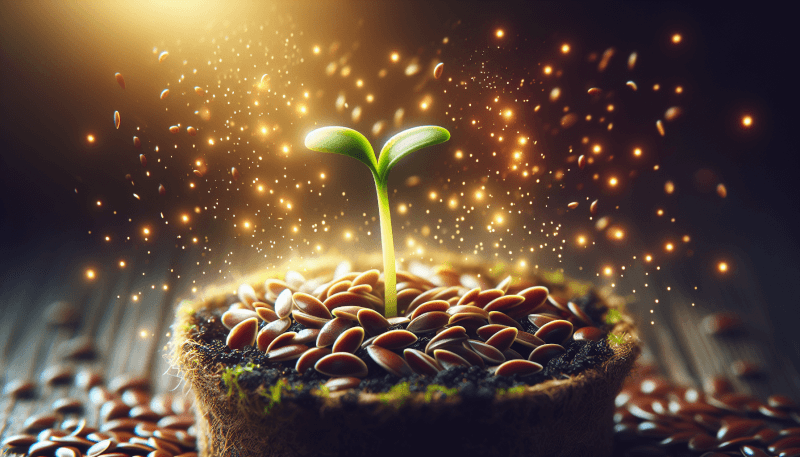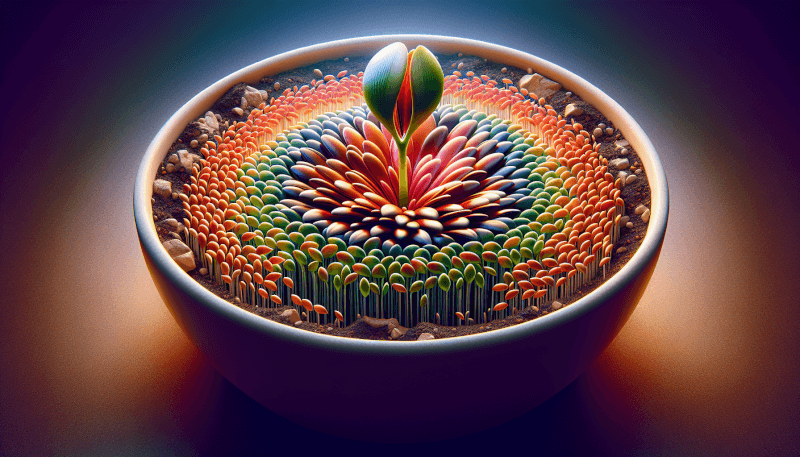👋 Click the mic button to talk to Alfred, the Todd's Seeds Gardening/Sprouting Expert – Feel free to ask him anything!
Ask Virtual Todd Anything - Click the Mic
Are you curious about the process of sprouting flax seeds? Look no further. In this article, we will walk you through a step-by-step guide on how to sprout flax seeds. From selecting the right seeds to providing the optimal conditions for sprouting, we’ve got you covered. By the end of this article, you’ll be equipped with the knowledge and confidence to start sprouting flax seeds at home, adding a healthy and nutritious twist to your meals. So, let’s get started on this exciting journey of sprouting flax seeds together!

Soaking the Flax Seeds
Choosing Flax Seeds
When sprouting flax seeds, it’s crucial to start with high-quality seeds. Look for organic and non-GMO flax seeds that are free from any additives. It’s also essential to ensure that the seeds are fresh and haven’t surpassed their expiration date.
Measuring the Flax Seeds
To determine the appropriate amount of flax seeds to soak, consider the desired yield and the capacity of your sprouting container. On average, a tablespoon of flax seeds typically yields about two tablespoons of sprouts. Adjust the quantity according to your preference and the available space.
Rinsing the Flax Seeds
Before soaking the flax seeds, give them a thorough rinse under cool running water. This step helps remove any debris or impurities that may be present on the seeds’ surface. Use a fine-mesh strainer to ensure efficient rinsing.
Soaking Time
Once the flax seeds are rinsed, place them in a bowl or jar and cover them with filtered water. Allow the seeds to soak for about 8-12 hours or overnight. Soaking softens the seeds’ outer shell and initiates the germination process, making it easier for them to sprout.
Preparing the Sprouting Container
Selecting a Container
Choose a sprouting container that is suitable for the volume of flax seeds you’re sprouting. Options include wide-mouthed jars, sprouting trays, or even shallow bowls. Ensure that the container has adequate drainage to prevent waterlogging and maintain optimal moisture levels.
Cleaning the Container
Before using the sprouting container, make sure it is thoroughly cleaned. Wash it with warm soapy water and rinse it well to remove any potential contaminants. Proper hygiene will minimize the risk of mold or bacterial growth during the sprouting process.
Adding Strainer or Cheesecloth
To facilitate proper drainage, place a fine-mesh strainer or a layer of cheesecloth over the container’s opening. This will prevent flax seeds from falling through and allow excess water to drain out easily. Secure the strainer or cheesecloth firmly to ensure it stays in place throughout the sprouting process.
The Sprouting Process
Draining the Soaked Flax Seeds
After the soaking time is complete, drain the water from the bowl or jar containing the soaked flax seeds. Tilt the container to remove as much water as possible, taking care not to spill any seeds.
Transferring to the Sprouting Container
Gently transfer the drained flax seeds to the sprouting container. Spread them out evenly to avoid overcrowding, which could hinder the sprouting process. Ensure that the container is kept clean and free from any leftover water.
Rinsing the Flax Seeds
Once the flax seeds are in the sprouting container, rinse them with fresh water. Fill the container partially with water, swish it around gently, and then pour out the water, along with any loose hulls or debris. Repeat the rinsing process 2-3 times to ensure the seeds are clean.
Drain and Rinse Cycle
To promote sprouting, establish a routine drain and rinse cycle. Typically, rinsing once every 8-12 hours is sufficient. After rinsing, ensure that excess water is drained thoroughly to prevent waterlogging. Maintaining a proper moisture balance is vital for successful sprouting.
Maintaining Optimal Moisture
During the sprouting process, it’s crucial to monitor and maintain optimal moisture levels. Excess moisture can lead to mold or bacterial growth, while insufficient moisture can hinder sprouting. Strive for a consistently moist environment without causing water saturation.
Monitoring Sprouting Progress
While sprouting flax seeds, keep an eye on their progress. Within a few days, small sprouts should begin to emerge. Continue with the regular drain and rinse cycle, observing the growth and making sure there are no signs of mold or any other issues. Be patient, as the sprouting time can vary depending on the temperature and other factors.

Caring for the Sprouts
Rinsing the Sprouts
Once your flax seeds have sprouted, continue to rinse them daily to maintain their freshness. Use gentle running water or fill the container partially with water, swish it around, and drain. This rinsing helps remove any residual hulls and keeps the sprouts clean.
Proper Air Circulation
After rinsing, ensure adequate air circulation around the sprouts. It’s essential for them to have access to fresh air to prevent excessive humidity and discourage mold growth. Place the container in an area with good ventilation, but avoid exposing the sprouts to direct drafts or strong airflow.
Avoiding Direct Sunlight
While sprouting, it’s best to keep the flax sprouts away from direct sunlight. Excessive heat and UV exposure can cause the sprouts to dry out quickly or become overheated, potentially damaging their delicate texture and nutritional properties. Instead, place the container in a well-lit area away from direct sunlight.
Temperature and Humidity Requirements
Flax sprouts thrive in moderate temperatures between 60-70°F (15-21°C). Avoid exposing them to extremely hot or cold environments, as temperature variations can inhibit proper growth. Additionally, maintain a humidity level of around 70% by rinsing and draining the sprouts regularly.
Preventing Mold or Bacteria Growth
To prevent the growth of mold or bacteria, thorough rinsing, proper drainage, and maintaining optimal moisture levels are crucial. If you notice any signs of mold, discoloration, or unpleasant odors, it’s best to discard the sprouts and start the process afresh.
Harvesting the Sprouts
Determining Sprout Readiness
Harvest your flax sprouts when they have reached your desired length. The sprouts should generally measure around 1-2 inches (2.5-5 cm) in length. Taste a few sprouts to ensure they have a mild, nutty flavor, indicating their readiness for consumption.
Trimming the Sprouts
Before using or storing the sprouts, trim off any residual hulls or roots. Use clean scissors or simply pinch them off gently. This step enhances the sprout’s appearance and texture, making them more enjoyable to eat.
Separating Seeds from Sprouts
If desired, you can separate the sprouted flax seeds from the remaining unhulled seeds at this stage. Gently agitate the sprouts with running water or swish them in a bowl filled with cold water. The sprouts will sink, while the unhulled seeds will float to the top, allowing for easy separation.
Storing and Using Sprouted Flax Seeds
Drying the Sprouts
To prolong the shelf life of sprouted flax seeds, it’s important to dry them thoroughly. While the sprouts are still moist, lay them out in a single layer on a clean kitchen towel or in a dehydrator. Allow them to air dry completely before storing or using. Proper drying prevents unwanted spoilage or bacterial growth.
Storing Sprouted Flax Seeds
Store the completely dried sprouted flax seeds in an airtight container or a resealable bag. Keep them in a cool, dry place away from direct sunlight and excessive moisture. Proper storage ensures their freshness and preserves their nutritional value for an extended period.
Incorporating Sprouts in Recipes
Sprouted flax seeds have a delightful crunch and nutty flavor. They can enhance various dishes, including salads, smoothies, sandwiches, and baked goods. Add them as a topping, mix them into doughs or batters, or blend them into spreads or dips. Be creative and enjoy the nutritional benefits they offer.
Health Benefits of Consuming Sprouted Flax Seeds
Sprouted flax seeds are loaded with nutrients and can be a valuable addition to a healthy diet. They are an excellent source of dietary fiber, omega-3 fatty acids, and various vitamins and minerals. Consuming sprouted flax seeds may promote heart health, aid digestion, and provide antioxidant benefits.
Troubleshooting Common Issues
Mold or Bacteria Growth
If you observe mold or detect an off-putting odor, it’s essential to discard the sprouts immediately. To prevent mold or bacteria growth, ensure proper drainage, maintain optimal moisture levels, and provide adequate air circulation. Starting with fresh and high-quality flax seeds is also crucial.
Undesirable Odors
If your sprouted flax seeds emit any unusual or foul odors, it’s an indication of potential spoilage or bacterial growth. In such cases, it’s best to err on the side of caution and discard the sprouts. Maintaining cleanliness throughout the sprouting process and proper drying can help prevent these issues.
Sliminess
Excessive moisture and inadequate drainage can lead to slimy sprouts. To prevent sliminess, adjust the rinsing and draining frequency accordingly and ensure proper air circulation. Trimming any residual hulls and drying the sprouts thoroughly before storage can also help alleviate this issue.
Uneven Sprouting
Uneven sprouting can occur due to variations in seed quality, age, or environmental conditions. While it’s difficult to achieve perfectly uniform sprouting, ensuring consistent moisture levels, proper drainage, and optimal temperature conditions can minimize the extent of unevenness.
Safety Precautions
Using Fresh and High-Quality Flax Seeds
To ensure food safety, always use fresh and high-quality flax seeds. Avoid using seeds that are past their expiration date or compromised in any way. Using organic and non-GMO flax seeds further minimizes the risks associated with contaminants or chemical residues.
Avoiding Contaminated Water
Water quality is crucial when sprouting flax seeds. Use filtered or purified water to avoid potential contaminants. If using tap water, ensure that it is from a reliable source and free from harmful bacteria or chemicals that could affect the sprouts’ safety and quality.
Proper Hygiene Practices
Throughout the sprouting process, maintain proper hygiene to prevent contamination. Wash your hands thoroughly before handling the flax seeds or sprouts. Clean all utensils, containers, and surfaces used during the sprouting process. Maintaining cleanliness reduces the risk of harmful bacteria or other pathogens.
Frequently Asked Questions
How long does it take to sprout flax seeds?
On average, flax seeds take around 2-4 days to sprout. However, the sprouting time can vary due to factors such as temperature, seed quality, and the specific variety of flax seeds being used.
Can I eat flax seeds without sprouting?
Yes, flax seeds can be consumed without sprouting. However, sprouting flax seeds enhances their nutritional value by activating enzymes, reducing antinutrients, and increasing digestibility. Sprouting also enhances their texture and flavor.
Can I use a sprouting jar instead of a container?
Yes, a sprouting jar is a suitable alternative to a container for sprouting flax seeds. It provides the necessary drainage and allows for easy rinsing. Just ensure that the jar has a fine-mesh screen or lid for efficient drainage.
Why are my flax seeds not sprouting?
Several factors can affect the sprouting process, leading to delayed or unsuccessful sprouting. Poor seed quality, inadequate moisture, incorrect temperature conditions, or insufficient rinsing and draining could be causing the issue. Adjusting these variables can help improve sprouting results.
Can I store sprouted flax seeds in the freezer?
Yes, you can store sprouted flax seeds in the freezer to extend their shelf life. Before freezing, ensure that the sprouts are thoroughly dried to prevent freezer burn. Seal them in airtight freezer bags or containers and label them with the date for easy reference.
Conclusion
Sprouting flax seeds is a simple and rewarding process that unlocks their nutritional potential and enhances their flavor. By following the step-by-step guide outlined above, you can enjoy fresh and crunchy sprouted flax seeds in just a matter of days. Experiment with incorporating these nutritious sprouts into your favorite dishes and reap the numerous health benefits they offer. With proper care and attention, you’ll soon become a pro at growing your own sprouted flax seeds!


